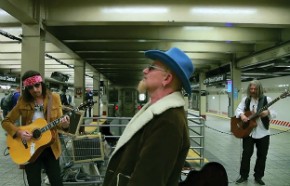Public intimacy

In May Jimmy Fallon and the band U2 staged a prank in a New York City subway station. Producers of The Tonight Show disguised U2 and Fallon with dime-store phony mustaches, hair, and glasses. Fallon faked a New York accent and told commuters passing by that these “local artists” would play for birthday parties and bar mitzvahs and that the buskers needed some “moneys.” Bono, dressed only slightly more ridiculously than usual, reared back and started to croon, sans microphone, “I Still Haven’t Found What I’m Looking For.” Drummer Larry Mullen beat on plastic buckets with sticks. Guitarist the Edge and bassist Adam Clayton played guitars that looked like they were from the closet in the church youth room.
People started to gawk before the end of the first stanza. A crowd gathered. Fallon said, “This isn’t working. Plan B,” and the group shed their disguises and ripped into the much more energetic “Desire.” By now the onlookers realized that they were getting something millionaires can’t buy: a concert two feet from Bono. They pulled out their cell phones and filmed themselves being filmed with U2, while Bono, ever the showman, hammed it up for them. It was hackneyed and manufactured, yet fun. Fallon had meant to create anonymity, but instead he created intimacy and spontaneous community.
I felt a similar dynamic at play in a more uncomfortable way at a recent funeral in our community. A 21-year-old had lost control of a new motorcycle and hit a truck head-on. His family members were celebrities in this small community: musical and political, they were loved. Everybody came to the funeral, and we watched as the boy’s parents said goodbye to him. It was an unbearably intimate moment, and the public couldn’t turn away and couldn’t stop crying. His mother touched his hair and bent to kiss him. His father buckled in agony. The coffin would soon close, and they’d never lay eyes on their boy’s body this side of the resurrection.





